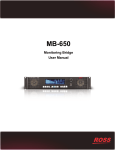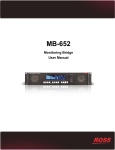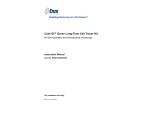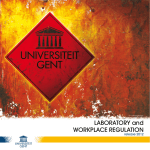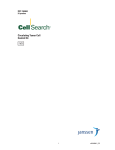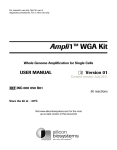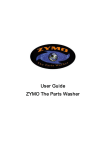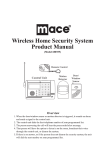Download Instructions For Use
Transcript
BCSI - SNAP Simple Nucleic Acid Processing Instructions for Use For Research Use Only Blood Cell Storage Inc. 454 North 34th Street Seattle, WA 98103 (478) 227-4005 JULY-12 Rev.01 Contents Product Information ............................................................................................................................. - 3 BCSI SNAP Products ...................................................................................................................... - 3 Storage ............................................................................................................................................. - 3 Equipment and Reagents Supplied by the User ............................................................................... - 3 Product Use Limitations .................................................................................................................. - 4 Quality Control ................................................................................................................................ - 4 Technical Assistance ....................................................................................................................... - 4 Safety Information ........................................................................................................................... - 4 General Procedure for Nucleic Acid Isolation..................................................................................... - 5 Reagent Preparation ......................................................................................................................... - 5 Card Loading ................................................................................................................................... - 6 Manual Washing of Cards ............................................................................................................... - 7 Manual Elution ................................................................................................................................ - 7 Automated Card Washing................................................................................................................ - 9 Automated Card Elution .................................................................................................................. - 9 On The Card Storage ....................................................................................................................... - 9 Application Notes .............................................................................................................................. - 11 BCSI Product Matrix ..................................................................................................................... - 11 Total Nucleic Acids from Plasma .................................................................................................. - 11 Total Nucleic Acids from FFPE Tissue Samples .......................................................................... - 13 Total Nucleic Acid from E. coli .................................................................................................... - 14 Viral RNA From Plasma ............................................................................................................... - 15 Appendix A: Risk and Safety Phrases ............................................................................................... - 16 - -2- Product Information BCSI SNAP Products Core Components: SNAP Cards SNAP Lysis GT Buffer SNAP Lysis GT-ND Buffer SNAP Wash 1 Concentrate SNAP Wash 2 Concentrate Elution Buffer 24 30 mL 15 mL 60 mL 60 mL 50 mL Supplemental Reagents (optional): SNAP Protease 1 SNAP Protease 2 SNAP Carrier 1 Storage SNAP products are stored at room temperature. Protect all SNAP Products from freezing. Refer to bottles for storage instructions for supplemental reagents. Equipment and Reagents Supplied by the User Pipettes Ethanol (95-100%) ACS/USP Grade Sodium dodecyl sulfate solution (Fluka Cat#71736 or equivalent) Xylene 1.7mL microcentrifuge tubes VWR 100-1000 l Wide Orifice Pipet Tips (Cat.# 89049-168) or equivalent to fit 1000 l pipette NOTE: It is critical to have tips that fit the ‘entry’ port of the SNAP Card Vortex Mixer Microcentrifuge Disposable Gloves Graduated Cylinder Vacuum Desiccator (for manual operation only) CAUTION: Do not use denatured alcohol, which contains other substances such as methanol or methylethylketone. -3- Product Use Limitations The BCSI SNAP product line consists of a set of general purpose reagents intended for research use only and accessory general research use equipment. This product is not intended for the diagnosis, prevention, or treatment of a disease. All due care and attention should be exercised in the handling of the products. We recommend all users of BCSI products adhere to the NIH guidelines that have been developed for recombinant DNA experiments, or to other applicable guidelines. Quality Control Application is for General Research Use. Technical Assistance www.bloodcellstorage.com/support Ph: 478-BCSI-005 (478-227-4005) M-F, 09:00-17:00 PST Email:[email protected] Safety Information When working with chemicals, always wear appropriate Personal Protective Equipment (PPE). If any of the reagents are spilled, clean the affected area with the use of absorbent towels or wipes. Rinse the affected areas with water as appropriate. Biological samples may be decontaminated by autoclaving. Disposal of unused reagents and biological samples should be according to local regulations. Refer to Appendix A for reagent specific safety information. For more information, please consult the appropriate material safety data sheets (MSDSs). These are available online in convenient and compact PDF format at www.bloodcellstorage.com on the Technical Support page where you can find, view, and print the MSDS for each BCSI kit and kit components. Further information is also provided on the last page of this booklet. -4- General Procedure for Nucleic Acid Isolation Reagent Preparation NOTE: To ensure reagent purity, DO NOT mix residual reagents from previous kits with fresh reagents being prepared. SNAP Lysis Buffer SNAP Lysis Buffer contains a high concentration of guanidine salts in solution. If the reagent has experienced low temperatures, some guanidine may come out of solution. Before use, check to see that the reagent is without precipitate. If precipitate is present, it may be necessary to warm the solution to redissolve completely. SNAP Wash 1 The Wash 1 bottle contains 60 mL of wash 1 concentrate. Add 30 mL of ethanol. Mix well. NOTE: Improper preparation of Wash 1 can result in failed extraction. SNAP Wash 2 The Wash 2 bottle contains 60 mL of wash 2 concentrate. Add 140 mL of ethanol. Mix well. NOTE: Improper preparation of Wash 2 can result in failed extraction. SNAP Elution Buffer The Elution buffer is shipped ready to use and is confirmed to be RNase free. CAUTION: Elution Buffer contains Sodium Azide. Additional Components Available from BCSI SNAP Protease 1 & SNAP Protease 2 A protease step during sample prep may increase the yield. BCSI provides two protease options, SNAP Protease 1 and SNAP Protease 2. Both are available in a convenient dropper. To prepare protease for use, remove from freezer thirty (30) minutes prior to reconstitution. To reconstitute, remove the cap from the bottle and the dropper attachment. Add 2 mL of elution buffer. Mix gently and then let the bottle sit for a few minutes to fully resuspend the protein. Then gently mix again. Reconstituted protease is best stored at -20°C for up to one year. The protease loses about 20% of activity when stored refrigerated and greater than 50% activity when stored at room temperature for 1 week. The reconstituted protease can undergo at least 12 freeze-thaw cycles without significant loss of activity. SNAP Carrier 1 Carrier RNA is available from BCSI. SNAP Carrier 1 is used in the extraction protocol to increase the yield of very small quantities of target RNA. However, the use of carrier is optional. It may be helpful to test the effectiveness of carrier in the user-defined application. Each tube of carrier contains 1 mg of dry poly(rA) RNA. Add 200 l of elution buffer. Mix well. Let sit for a few minutes and mix well once again. It is best to prepare smaller aliquots of the carrier RNA and store these at -20°C for up to one year. CAUTION: DO NOT add bleach or acidic solutions to the sample preparation waste. The Lysis Buffer and Wash 1 solutions contain high concentrations of Guanidine, which can form toxic compounds when combined with bleach. -5- Card Loading This section describes how to load a prepared sample into a BCSI Extraction Card. To determine the sample preparation appropriate for your application, please refer to the Application Notes section of this document. The procedure described below is for a 1.5 mL total volume containing 0.5 mL sample, 0.5 mL lysis buffer, and 0.5 mL ethanol. The channel in the isolation card has a total volume of 1.2-1.5 mL. However, lower volumes can be loaded onto the card. (1) With a 1 mL pipetor fixed with a wide orifice pipet tip, load on the entire sample through the entry port. Ensure there is a tight seal with the pipette tip and the entry port to prevent sample leakage. Slowly depress plunger to load the sample. Try not to introduce excessive bubbles. Repeat as needed to fill the card. (2) Wipe any residual sample or sample deposits from the surface of the card. Direction of wiping should be away from the exit port. Take care to avoid contaminating the exit port. (3) Incubate at room temperature to allow binding of nucleic acids Note: The binding time will rely on the sample type being analyzed. Refer to Application Notes for suggested binding times. Entry Port Exit Port -6- Manual Washing of Cards (1) With a wide bore pipet tip, remove the sample from the card through the exit port. Try to remove as much residual sample as possible. CAUTION: Do not attempt to decontaminate biological samples with bleach. Samples containing guanidine may be autoclaved. (2) Fill the channel through the entry port with prepared Wash 1. Let sit for one (1) minute, and then remove through the exit port. Repeat for a total of two washes. Remove as much residual Wash 1 as possible. (3) Fill the channel with prepared Wash 2. Let sit for one (1) minute, and then remove through the exit port. Repeat for a total of 6 washes. Remove as much residual Wash 2 as possible. (4) Place cards in vacuum desiccator until the interior surface is visually dry. (5) Proceed to manual elution. To facilitate manual card processing, the SNAP-M kit is available from BCSI. The SNAP-M kit enables gravity driven flow to simplify the wash process and includes a quick and easy drying option. See www.bloodcellstorage.com to learn more about the SNAP-M option. Manual Elution Elution is to be performed on cards after washing and drying are complete. (1) Aliquot 100-200 μl of Elution Buffer to a fresh clean tube. (2) With a fresh 1 mL pipet tip, transfer the Elution Buffer to the exit port. (3) Move the “Bubble” of Elution Buffer from the exit port to the entry port slowly. Buffer is in good contact with the entire S-channel surface. The goal is to assure that the Elution Occasionally, the “Bubble” will break contact with the side of the channel and the bubble will not move. Lightly tap the card on its side to re-establish contact and complete the elution. (4) Allow the bubble to sit at entry point for 10-20 minutes. Move the bubble slowly from the entry port to the exit port and remove the eluate through the exit port to a clean tube. When introducing Elution Buffer into a dry card, it is normal for some of the liquid to be retained by the card. Depending on the properties of the sample, expected volume recovered can range between 50-75% of volume introduced. (5) Repeating the elution process may allow additional recovery of nucleic acids. Repeated sweeping of the channel with the elution bubble does not significantly increase yield. A second elution should be performed with fresh Elution Buffer -7- BCSI Nucleic Acid Extraction System Guide Removal of Eluate With Manual Elution Exit Port Entry Port BCSI Nucleic Acid Extraction Card Step 3: Introduce Elution Buffer through the Exit Port. Step 6: Draw elution bubble towards Exit Port. Sample In Step 1: Load Sample and Incubate to Allow Nucleic Acid Binding. Step 4: Move the “Bubble” of Elution Buffer towards the Entry Port Remove Sample Through Entry Port. Wash In Wash Out Step 2: Wash and Dry Card. Step 5: Draw the elution bubble back towards the Exit Port. -8- Step 7: Remove elution bubble through the Exit Port. Automated Card Washing (1) Prepare the wash station, SNAP-R, for use according to its user manual. Be sure to follow all instructions for maintaining equipment cleanliness. (2) Load the card onto the card washing station, following the procedure described in the equipment documentation. Program the wash station using the parameters listed below. Start the program. The station will wash the channel on the card thoroughly, dry away residual ethanol, and if desired, introduce the elution buffer to the card. Wash Parameters Wash 1 2 Washes of 1 mL each Wash 2 6 Washes of 1 mL each Drying Time 3 Minutes Elution Volume* 100-200 μl *If manual elution is to be performed, ensure the wash station program does not call for elution to be introduced by the machine. Automated Card Elution The machine will introduce the elution buffer and move it most of the way through the channel. When the machine protocol finishes, the eluate will be located within the S-channel. With a 1 mL pipette tip, carefully move the eluate to the end of the channel nearest the entry port by pushing from the exit port. Once it has reached the end of the glass portion of the channel, reverse its flow and pull it back through the channel to remove the eluate through the exit port to a clean tube. On The Card Storage BCSI SNAP Cards offer stable storage of purified Nucleic Acids at room temperature. To take advantage of this feature, simply stop processing after the card drying step. Note, if using the SNAP-R automated wash station, ensure it is not programmed to automatically introduce the elution. Once dry the cards can be stored at room temperature. To recover your NA, simply elute as usual at a later date. RNA can be recovered up to seven days after washing and DNA can be recovered up to six months after washing. -9- BCSI Nucleic Acid Extraction System Guide Removal of Eluate After Automated Elution Exit Port Entry Port Step 1: Remove card from wash station. Elution bubble is located away from the Entry Port. Step 2: With a pipettor at the Exit Port, push the elution bubble towards the end of the channel nearest the Entry Port. Step 3: With a pipettor at the Exit Port, draw the elution bubble back through the channel. Step 4: With a pipettor at the Exit Port, remove the eluate into a clean tube. - 10 - Application Notes BCSI Product Matrix BCSI is developing new applications and improved protocols on an ongoing basis. The most current revision of this document will always be available through our website, www.bloodcellstorage.com. User Reference Ordering Info BCSI Kit Lysis Buffer Protease Carrier Applications Total NA from Plasma SNAP-02-002R-0 GT SNAP Protease 1 N/A Total NA from FFPE Tissue SNAP-02-004R-0 GT SNAP Protease 2 N/A Total NA from E. coli SNAP-02-005R-0 GT SNAP Protease 2 N/A Viral RNA from Plasma SNAP-02-006R-0 GT-ND SNAP Protease 1 SNAP Carrier 1 Total Nucleic Acids from Plasma 1) Required Reagents 1. 2. BCSI SNAP GT Lysis BCSI SNAP Protease 1 2) Sample Preparation (1) (2) (3) (4) Aliquot 0.5 mL of Cell Free Plasma into 1.7 mL tubes. Add 1 drop BCSI SNAP Protease 1 (Diluted to 5 mg/mL as instructed; 200 μg). Incubate at room temperature or higher for 30 minutes. Add 1 mL SNAP GT Lysis buffer and mix well. 3) Rapid Procedure from 0.5 mL Plasma (1) Load the sample into a SNAP card. Let the sample sit for at least 30 minutes. (2) Wash and dry as directed. (3) Elute using 100 μl Elution Buffer. 4) High Yield Procedure A : The high yield procedure yields 2-3 times more nucleic acid using 2 mL of plasma than the rapid protocol. Higher yields can be obtained by increasing the number of plasma loading steps or increasing the binding time. (1) (2) (3) (4) (5) (6) (7) Prepare four separate tubes of sample for each card. Load the first sample onto a card and let sit for at least 30 minutes to allow nucleic acid adsorption. Remove the sample and discard in biological waste. Load on the second sample. Let sit for at least 30 minutes. Remove the sample and repeat with the remaining 2 sample tubes for a total of 4 “steps”. Wash and dry as directed in the Instructions for Use. Elute using 100 µl Elution Buffer. - 11 - 4) High Yield Procedure B : This procedure yields at least 2 times more nucleic acid than the rapid protocol. It uses 2 extraction cards and 1 mL of plasma and a serial elution procedure in which the eluate from the first card is used to elute the second card. (1) Prepare two separate tubes of sample, each using 0.5 mL sample. (2) Load the samples onto each of two cards and let sit for a minimum of 2 hours to allow nucleic acid adsorption. Overnight incubation at room temperature gives the best yield. (3) Wash and dry the cards as directed by the Instructions for Use. (4) To serially elute the cards, carefully load 150 µl of elution buffer on the first card. Slowly move the buffer to the opposite port and let the buffer sit on the card for 10 – 20 minutes. Then slowly bring the elution buffer back across the channel and remove. (5) Load the retrieved elution buffer sample from the previous elution onto the second card. Move it to the opposite port and allow to sit for 10 – 20 minutes. (6) Slowly bring the elution buffer carefully back across the channel and remove. The sample is now ready to use. - 12 - Total Nucleic Acids from FFPE Tissue Samples 1) Required Reagents 1. 2. 3. 4. 5. 6. BCSI SNAP GT Lysis BCSI SNAP Protease 2 PinPoint™ Solution (Zymo Research: Catalog Number D3001-1) Xylene Pure Ethanol (100%) 0.1% SDS in water (Dilute a 10% SDS Solution such as Fluka Cat#71736 1:100 in pure water) PinPoint™ solution is used only for the protocol listed under section B below. 2) Deparaffinize Tissue Sections (1) (2) (3) (4) (5) Immerse slides in xylene for 15 minutes. Transfer slides to a second xylene bath for 15 minutes Immerse slides in a pure ethanol bath for 5 minutes Repeat the ethanol bath twice more for a total of 3 ethanol baths. Allow slides to dry at room temperature. 3) Sample Preparation Using SDS (1) Pipet 50 µl of 0.1% SDS onto the dried section. Scrape up section using a pipet tip and transfer as completely as possible to a 1.7 mL tube. : It is difficult to remove all of the section using a small aliquot of SDS. The following two washing steps are done to remove as much residual tissue section as possible. (2) (3) (4) (5) (6) Add 100 µl of 0.1% SDS to the slide and scrape up and remove any remaining section. Rinse the slide with an additional 100 µl aliquot of 0.1% SDS. Combine all in the 1.7 mL tube. Add 50 µl SNAP Protease 2. Incubate overnight at 55ºC; follow by a 70ºC heat pulse for one hour. Add 600 µl SNAP GT Lysis Buffer and mix well. Proceed to Section 5) below. 4) Nucleic Acid Isolation on BCSI Extraction Cards (1) Load the entire sample onto an extraction card. There is less volume of sample at this point (Sample Volume = 0.9 mL) than can fit in the channel (Total Volume = 1.5 mL). Move the sample over the entire surface of the glass to completely coat the channel and “park” the sample over the center of the card. (2) Let the nucleic acids adsorb to the glass for at least 30 minutes. Longer adsorption times may increase the yield. (3) Wash and dry the cards as directed. (4) Elute the bound nucleic acids using 100 µl elution buffer. - 13 - Total Nucleic Acid from E. coli Note: This procedure is for extraction of total nucleic acid from isolated colonies or broth cultures of E. coli. Extraction of other bacterial species or of E. coli from other sample types may require further optimization. Extraction of gram positive species and yeasts will require additional enzymatic digestion to increase the efficiency of extraction. 1) Required Reagents (1) BCSI SNAP GT Lysis (2) BCSI SNAP Protease 2 (Dissolved to 5 mg/mL) (3) Resuspension Buffer contains 1% SDS (Sodium dodecyl sulfate). 2) Sample Preparation (1) From an agar plate: Scrape up an appropriate number of colonies into 0.5 mL of Resuspension buffer. Vortex to obtain an even suspension. (2) From a liquid culture: Transfer a sample of the liquid culture to a 1.7 mL tube. Pellet the bacteria by spinning in a microcentrifuge for 2 minutes. Suspend the bacterial pellet in 0.5 mL Resuspension buffer using a vortex mixer to obtain an even suspension. (3) Add 1 drop SNAP Protease 2 solution and mix well. Allow the sample to digest for 30 minutes at room temperature. 3) Extraction Procedure (1) (2) (3) (4) (5) Add 1 mL SNAP GT Lysis buffer to the sample. The E. coli suspension will become clear on GT buffer addition. Load the sample onto an extraction card as outlined in detail above. Let the card sit at room temperature for 30 minutes. Wash and dry the card as directed above. Elute bound nucleic acid with 100-200 µl Elution Buffer - 14 - Viral RNA From Plasma 1) Required Reagents (1) BCSI SNAP GT-ND Lysis (2) BCSI SNAP Protease 1 (3) BCSI-SNAP Carrier 1 2)Procedure (1) Pipet 0.5ml of sample containing phage into a 1.7ml microcentrifuge tube. NOTE: If less than 0.5ml of sample is to be used, add pure water or additional UVTM to a final volume of 0.5ml and follow the procedure below. (2) Add 1 drop (40μl) protease. Mix well either by vortexing the mixture and spinning briefly to collect clinging drops in the cap, or by using a pipetor. Incubate at room temperature for at least 30 minutes. NOTE: If the sample is water, the protease step is optional. (3) Add 0.5ml of GTND Buffer and 0.5ml pure ethanol and mix well. (4) With a 1 ml pipetor fixed with a wide orifice pipet tip, load on the entire sample through the entry port. Try not to introduce excessive bubbles. Let sit at least 30 minutes or up to 2 hours. Longer binding times may result in increased capture. (5) Wipe any residual sample or sample deposits from the surface of the card. (6) Wash and dry the cards per the above general instructions. - 15 - Appendix A: Risk and Safety Phrases Component Hazard Contents Hazard Code Risk Phrases Safety Phrases SNAP GT Lysis Guanidine thiocyanate Xn 20, 21, 22, 32, 52, 53 13, 22, 61 SNAP Wash 1 Concentrate Guanidine hydrochloride Xn 20, 21, 22, 32, 52, 53 13, 22, 61 SNAP Protease 1 Subtilisin Xn 36, 37, 38, 42 22, 24, 26, 36, 37,39 SNAP Protease 2 Proteinase K Xn 36, 37, 38, 42 22,24,26,36,37,39 SNAP Wash 2 Concentrate Proclin 150 C 34, 43 26, 36/37/39, 45 SNAP Elution Sodium Azide T+, N 28, 32, 50, 53 28, 45, 60, 61 SNAP Carrier 1 poly(rA) NA NA 36/37 Hazard Codes Xn ............................ Harmful C .............................. Corrosive N .............................. Dangerous for the environment T+ ............................ Very Toxic Risk Phrases 22 ............................. Harmful if Swallowed 28 ............................. Very Toxic if swallowed 32 ............................. Contact with acids liberates very toxic gas 34 ............................. Causes burns 41 ............................. Risk of serious damage to eyes 42 ............................. May cause sensitization by inhalation 43 ............................. May cause sensitization by skin contact 20/21/22 ................... Harmful by inhalation, in contact with skin and if swallowed 36/37/38 ................... Irritating to eyes, respiratory system, and skin 37/38 ........................ Irritating to respiratory system and skin 50/53 ........................ Very Toxic to aquatic organisms, may cause long-term adverse effects in the aquatic environment 51/53 ........................ Toxic to aquatic organisms, may cause long-term adverse effects in the aquatic environment 52/53 ........................ Harmful to aquatic organisms, may cause long-term adverse effects in the aquatic environment Safety Phrases 13 ............................. Keep away from food, drink, and animal feeding stuffs 22 ............................. Do not breathe dust 24 ............................. Avoid contact with skin 26 ............................. In case of contact with eyes, rinse immediately with plenty of water and seek medical advice 28 ............................. After contact with skin, wash immediately with plenty of water. 45 ............................. In case of accident or if you feel unwell, seek medical advice immediately (show label where possible) 60 ............................. This material and/or its container must be disposed of as hazardous waste 61 ............................. Avoid release to the environment. Refer to special instructions Safety Data Sheet 36/39 ........................ Wear suitable protective clothing and eye/face protection 36/37 ........................ Wear suitable protective clothing and gloves 36/37/39 ................... Wear suitable protective clothing, gloves, and eye/face protection - 16 -
















